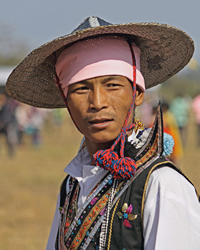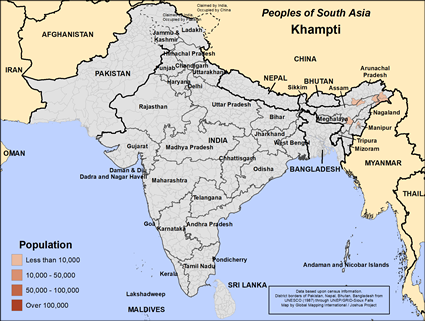Khampti in India

Photo Source:
Asia Harvest-Operation Myanmar
|

Map Source:
People Group data: Omid. Map geography: UNESCO / GMI. Map Design: Joshua Project
|
| People Name: | Khampti |
| Country: | India |
| 10/40 Window: | Yes |
| Population: | 18,000 |
| World Population: | 27,000 |
| Primary Language: | Adi |
| Primary Religion: | Buddhism |
| Christian Adherents: | 0.91 % |
| Evangelicals: | 0.00 % |
| Scripture: | Complete Bible |
| Ministry Resources: | Yes |
| Jesus Film: | Yes |
| Audio Recordings: | Yes |
| People Cluster: | South Asia Buddhist |
| Affinity Bloc: | South Asian Peoples |
| Progress Level: |
|
Introduction / History
Khamti people live in the area where the three countries of Myanmar, India and China meet. The name Khamti means "a land full of gold." Historians say that the Khamti migrated to India from the Irrawaddy valley, Myanmar, in 1751. They settled along the Tangapani River. They later moved and now inhabit the lower regions drained by the Tangapani and Noa-Dihing rivers.... Their territory is surrounded by dense forests of the tropical moist deciduous type.
Some Khamti now live in Kachin State of north-western Myanmar, having first settled along the Chinwin River in the 12th century AD. They formed three small Khamti Long Thai States and developed a highly advanced civilization. Those who escaped enslavement by the Burmese settled in their present location in the fertile triangle of northern Myanmar, between the Mali and Nmai rivers.
Most Khamti people live across the border in northeast India's states of Arunachal Pradesh and Assam, where they are recognized as a scheduled (official) tribe. In Arunachal Pradesh they inhabit the plains of Lohit, Changlang, Lower Subansiri and Tirup districts, as well as the Dibang Valley. Additional numbers of Khamti inhabit Assam State.
What Are Their Lives Like?
One researcher there found that though the Khamti are Buddhists, they eat a variety of fish. They consume the meat of fowls, pigs, goats, bears, deer and tigers. Beef is a taboo. Khamti society is hierarchical, with the village chief at the top, followed by the Buddhist monks, the common people and the former slaves at the bottom.
When a Khamti couple gets married, a mediator accompanies the groom's relatives (barring his parents) to the bride's house in a procession. The groom's party offers a basket of dried fish and rice beer to the bride's parents. When the entertainment is over the mediator negotiates with the bride's father, whereupon he hands over his daughter to the groom's party.
What Are Their Beliefs?
Theravada Buddhism is the religion of almost every Khamti person. Each village has its own monastery, where proud parents send their sons to study the teachings of Buddha. These peace-loving people make offerings of flowers and food.
What Are Their Needs?
No matter where they live, few Khamti have any awareness of the son of God who died that they may have eternal life.
Prayer Points
Pray for a movement of Jesus to heal and strengthen Khampti communities.
Pray for a "Book of Acts" type of movement to Christ among the Khampti.
Pray for the Khampti people to understand and embrace that Jesus wants to bless their families and neighborhoods.
Pray for Holy Spirit anointed believers from the Khampti people to change their society from within.
Pray for a movement in which the Holy Spirit leads and empowers disciples to make more disciples.